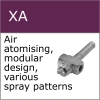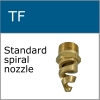Dust Suppression
Engineering consideration 3 - Spraying in windy conditions
The motion of air in the dusty environment can have a significant impact on nozzle selection. As discussed in the droplet size matching (engineering consideration 2) fine droplet sizes are good for dust suppression. However, fine sprays are more easily carried and disrupted by air flows. So in windy environments very fine sprays are in danger of being blown away before they can interact with the dust.
Larger droplets
In order to overcome this a spray with some coarser droplets present in the mix may actually be the optimum for dust suppression. The TF spiral nozzles that SNP offer do produce relatively fine sprays but have a broad spectrum of droplet sizes. This means that the larger droplets help carry the smaller ones with them so that they can deliver effective dust suppression in more windy environments.
Air Atomising Nozzles
Another solution is to help project a fine spray into windy environments by either using fans or using pressurised air. Air atomising nozzles (like the XA) use pressurised air to break up the spraying fluid, but also use the air to throw the spray from the orifice. This gives the fine sprays produced by these nozzles more momentum and means they can effectively control dust in more windy conditions.
Nozzle details
Full technical details on the nozzles mentioned above can be accessed by clicking on the product boxes below. For more details of how the features of these products relate to dust suppression applications please click on the relevant product family in the "Dust Suppression Nozzle Designs" menu to the right hand side of this page.

